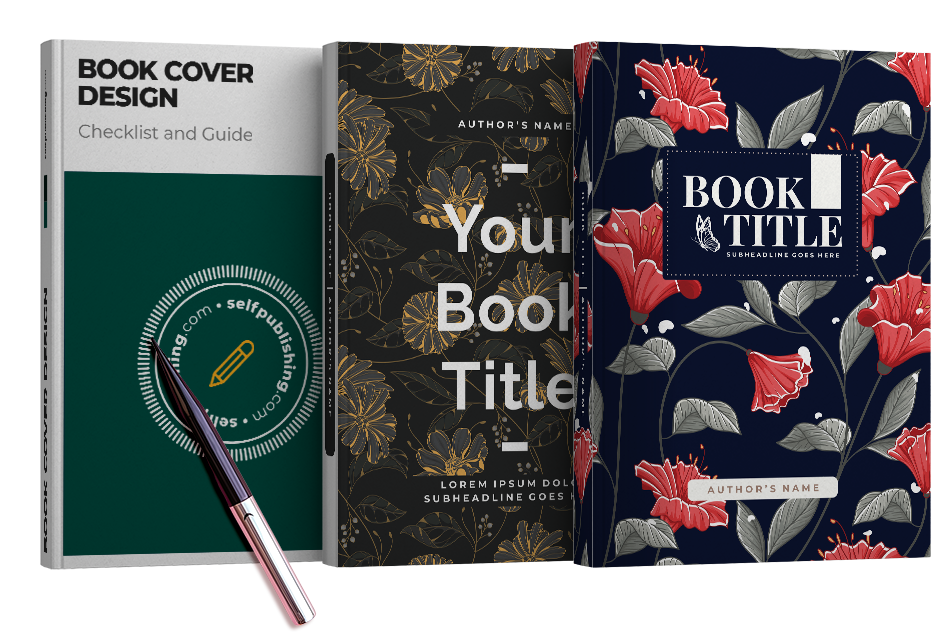The setting of a story is a powerful driver for hooking readers.
Does your setting help tell your story? Does it deepen your plot and enrich your characters? Does your setting engage the reader by setting the mood and increasing the emotional connection to your characters? What is the setting of a story, anyway?
All these are important questions you should ask yourself if you plan to write a novel.
Getting your setting “properly written” can be the difference between a huge hit or a bad miss. Too many details, and they get skimmed and skipped. But not enough details and the characters will have no place to just “be.”
I said that the setting enriches the characters. What I didn’t tell you is that it helps to form the characters and even the characters’ motivations. It does the same for the plot.
In this article, I’m going to show you how to write the setting of a story so that it’s engaging to your readers.
What is the setting of a story?
The setting of a story is the context in a scene or story that describes the elements in which a story takes place, including time, place, and environment. Each component in the setting helps to build the narrative’s mood, plot, and character development.
Exposition is key in introducing the story’s setting to the audience, offering vital background details that set the scene. It outlines the when and where, along with important social, historical, or cultural contexts, essential for grasping the plot and character motivations.
Many people mistakenly believe that the setting is only the backdrop to the story when, in fact, it includes everything that has to do with the social environment, place, and time.
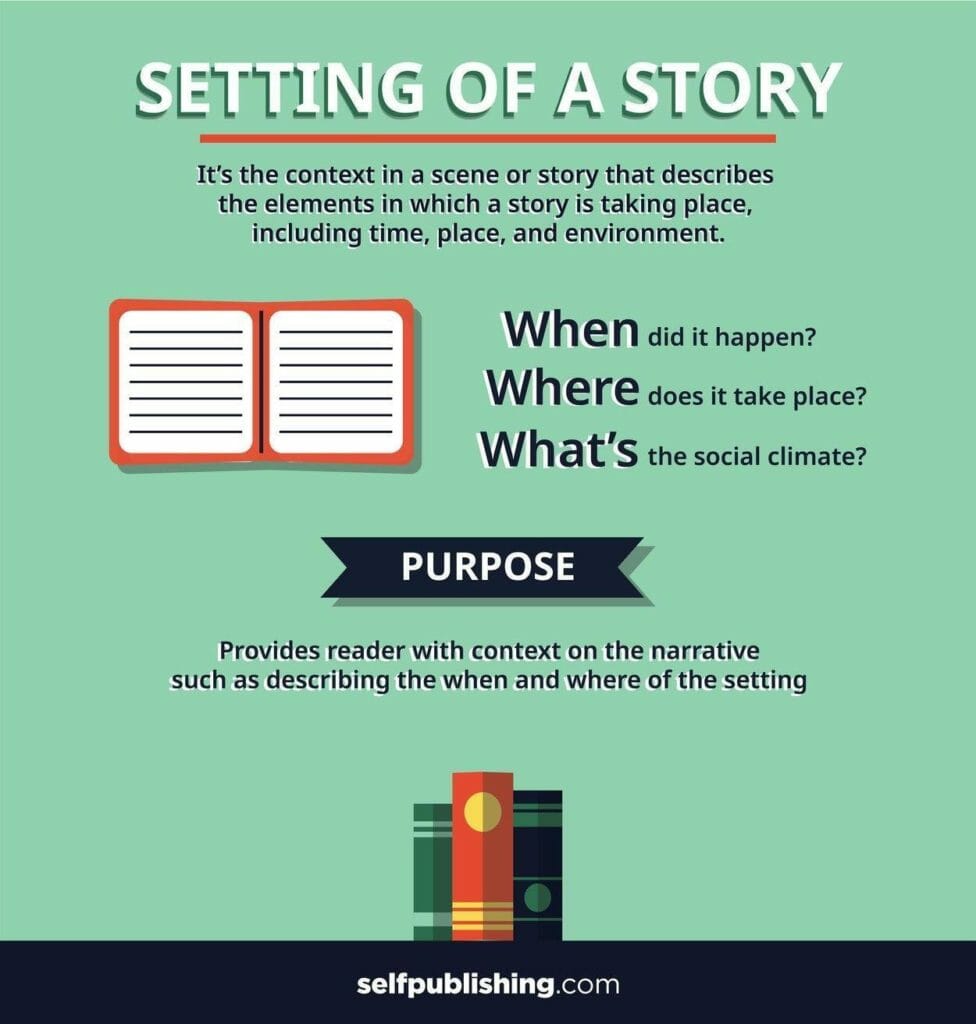
What is the setting of a story’s purpose?
In short, the setting of a story has an important purpose in providing the reader with context on the narrative, such as describing the when and where of the setting.
Where does it take place? What’s the social climate? What time period is it? What important events are happening in the world? What are the social norms and expectations? What’s the weather like? What season is it in? These are all questions that serve a purpose in the story’s setting.
Related: 4 Exposition Mistakes And How To Avoid Them
What is an example of a setting?
Here is an example of the setting of a story from author Nora Roberts, who is describing Ireland in The Dark Witch: “The cold carved bone deep, fueled by the lash of the wind, iced by the drowning rain gushing from a bloated sky. Such was Iona’s welcome to Ireland. She loved it. How could she not? she asked herself as she hugged her arms to her chest and drank in the wild, soggy view from her window. She was standing in a castle. She’d sleep in a castle that night. An honest-to-God castle in the heart of the west.”
Notice the bolded words, and how they help the reader envision the place, social environment, and time of the story.
There are many stellar examples of setting written not only in fiction novels, but also in non-fiction books as well.
Let’s go through another setting of a story example, and how it relates to the experience a reader has.
If I were to talk about the old Volkswagen Beetle that Sarah was sitting in as she was bouncing down a bumpy back alleyway in Manhattan, you’d know where she was.
If I were to write about the Volkswagen—musty with the strong smell of stale sweat hanging heavy in the air, the plot thickens.
If I were to show you that the sky is dark, there’s a cold drizzle outside, the wind is gusty, and that Sarah’s inner thoughts reflect that, “Even the weather knows how I feel,” we have some insight into the depressed state of the protagonist.
Show, don’t tell in your writing.
Show the readers the setting of a story through powerful writing and the use of literary devices.
Why is the setting of a story important?
The setting of a story is important because it provides the reader with context on the time, place, and environment that the story takes place in. It is also important because it improves the reader’s experience and adds to the story’s development with plot, mood, and characters.
Whether you are learning how to write a nonfiction book or a novel, the setting of a story is crucial to that story’s development, and the reader’s experience, for a number of reasons.
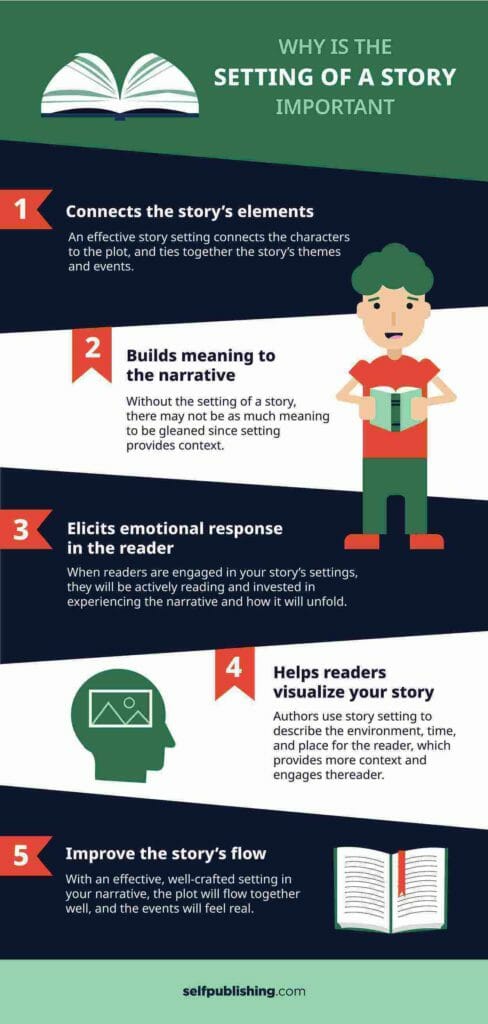
Here’s why the setting of a story is important:
- It connects the story’s elements. An effective story setting connects the characters to the plot, and ties together the book’s themes and events.
- It builds meaning to the narrative. Without the setting, there may not be as much meaning to be gleaned since setting provides context.
- It elicits emotional responses in the reader. When readers are engaged in your story’s setting, they will be actively reading and invested in experiencing the narrative and how it unfolds.
- It helps readers visualize your story. Authors use setting to describe the environment, time, and place for the reader, which provides more context and engages the reader.
- It improves the story’s flow. With an effective, well-crafted setting in your narrative, the plot will flow together well, and the events will feel real.
How to decide the setting of a story
When you’re learning how to write a book, there are three important points you should consider when deciding where the story’s setting will be.
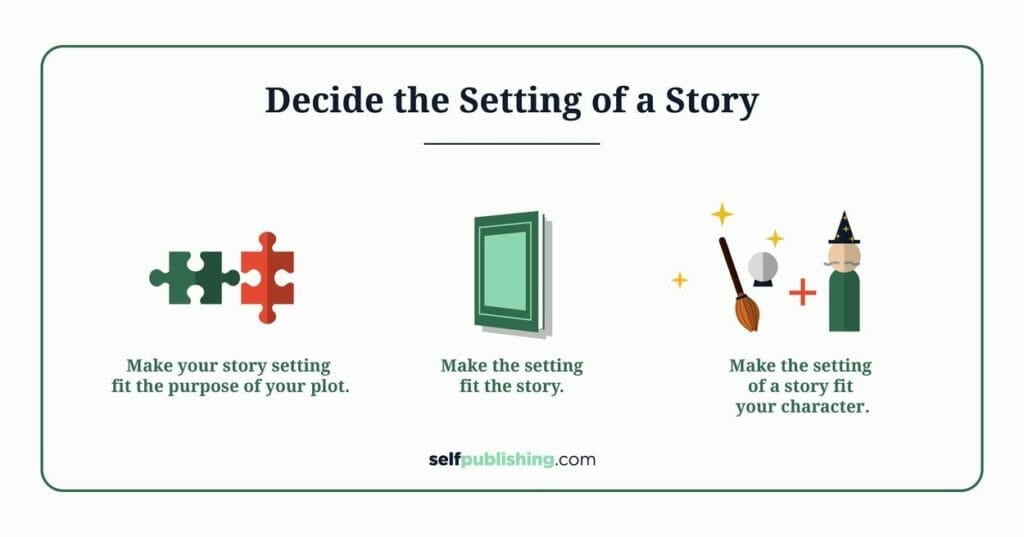
Make your setting fit the purpose of your plot
Your setting should be aligned to your plot so that it all makes sense to your reader, and is realistic.
Are you trying for a murder mystery? To fit that purpose, make the story setting be in Chicago with high crime rates, many places to hide, and a resourceful police station.
Do you want it to feel fast-paced, or like a slow and steady Sherlock Holmes mystery? To accomplish that, a rural, backwoods setting will be more appropriate.
See how the setting of a story should make sense for the overall plot?
Make the setting fit the story
The setting of a story should fit the actual story; things, events, or objects within a story’s setting should not feel out of place to the reader, based on prior knowledge of a place or time period.
For example, does the Volkswagen on the bumpy road carry a car full of lawbreakers? They’ll probably not want to draw attention. Place them in America in an era when old Volkswagens were common.
Make the setting fit your character
Last but not least, the setting of a story should always be aligned with the main characters found within that story. In other words, you should build your setting and your character bio template simultaneously.
For example, is your character shy and withdrawn? Have her sitting on the ledge surrounding the red brick school building writing short stories in her mom’s old notebook instead of enjoying recess with the other kids.
How to research the setting of a story
When researching the setting a story, there are many things to consider:
- What nationalities are represented in the population?
- How dense is the population?
- What is the primary religion of the area?
- What other religions are there?
- What old wives’ tales and superstitions are there that might shape the plot and the reactions of the main character and the population to outside influences?
- What are the terrain and other geographical features?
- What are the typical weather patterns for that time of year?
- What is the climate like?
- What is the government like?
- What is the history of the area?
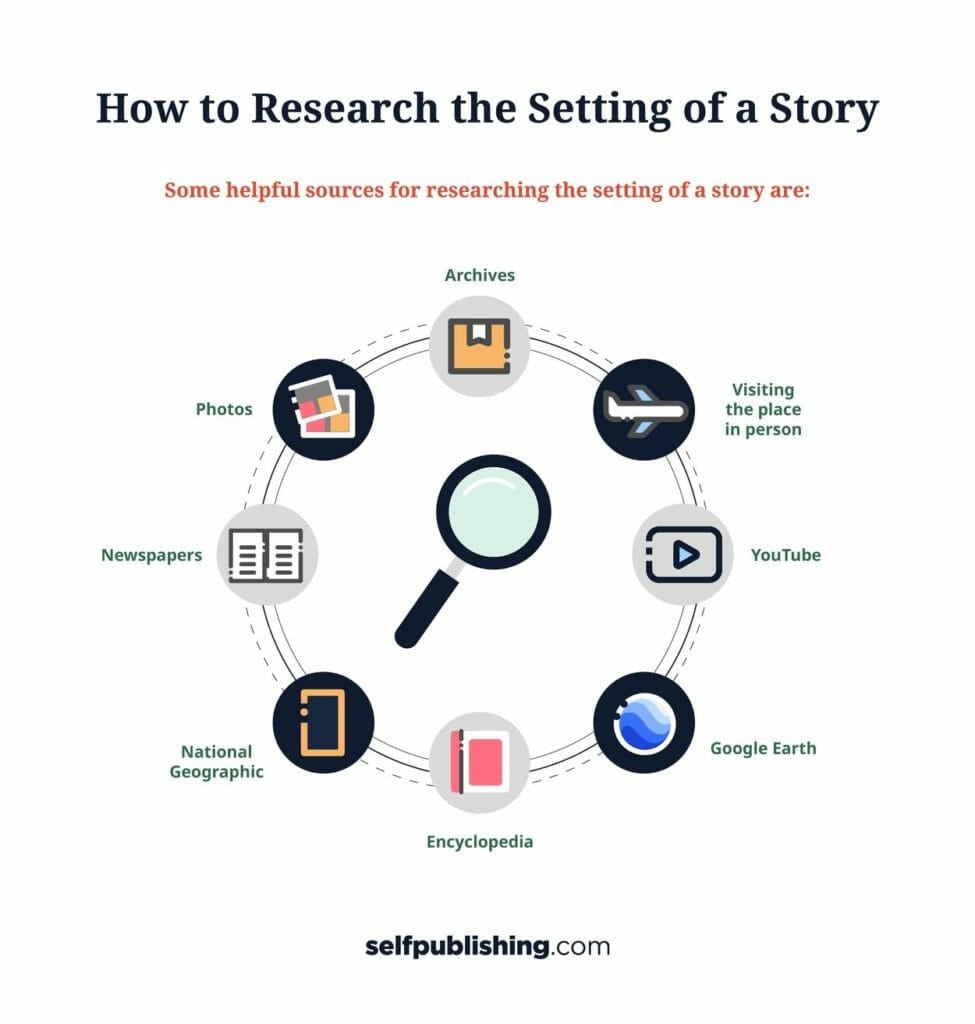
Some helpful sources for researching the setting of a story are:
- Visiting the place in person. This is the best way to get a real-life, hands-on feel for a setting, but it’s not always possible, especially if you don’t have a budget or if you’re writing about an imaginary place.
- YouTube. You can do a quick search on YouTube to find footage of many sites.
- Google Earth. This is a great resource, and one that will give you an idea of the terrain and general appearance of a place.
- Encyclopedias. Don’t forget to use a handy encyclopedia!
- National Geographic. It’s a great resource for high quality images.
- Newspapers. While more time consuming than doing a quick online search, they are first-hand research.
- Photos. Do a Google search for “photos of [what you are searching for]”
- Archives. First-hand research where you’re sure to find a wealth of information on your topic.
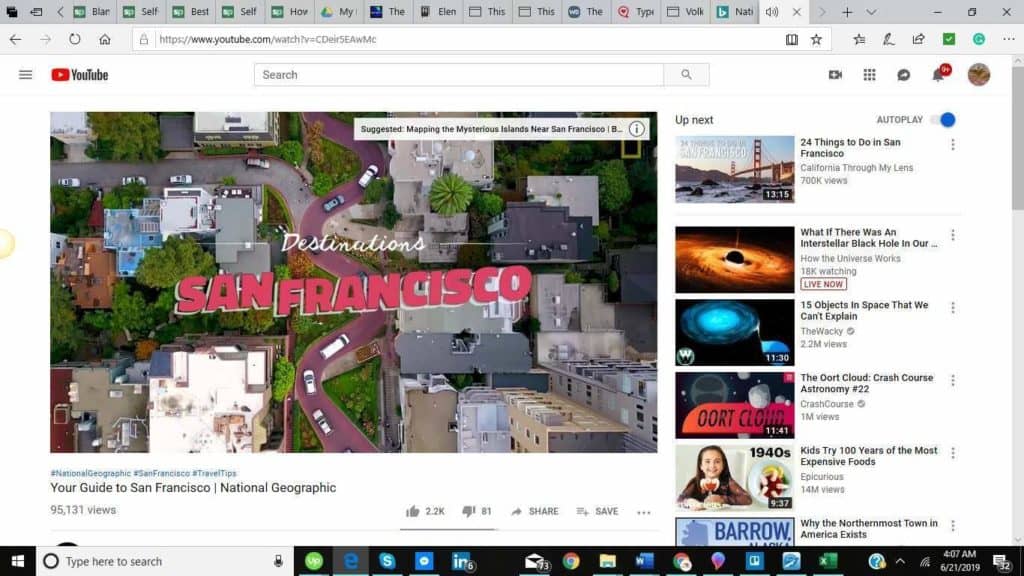
8 tips for how to write the setting of a story
Creating an engaging setting for your reader can be difficult. Think of the setting like a very large puzzle – it takes a lot of detailed pieces to make the big picture appear seamless.
Through detailed research and a lot of thought, you can create a setting that aligns for your reader by using these tips.
1. Decide what mood you’re trying to establish
Mood is defined as the overall feeling the reader has when reading a story, and it is created by the author.
What mood are you trying to establish?
How do you want readers to feel as they read your story? Think on that, then create that mood with your writing.
Think of it in terms of this: A bright summer morning in the middle of a large, grassy park where happy families are out and about casts a much different mood than a dark forest with crooked, gnarled trees and low-hanging fog.
2. Decide which period or moment best fits the context of your story
The time period plays a huge part in developing the setting of a story.
What kind of plot do you have? Does it best fit into medieval Europe, America’s 1960s, or in current time? Or maybe it fits better in the future?
Look at the language you’re planning to use—the idioms, quotes, and expressions. Look at the props and the way the characters view them.
Consider how the different people in the book are treated. Are the elderly respected? Are the police viewed as an authority? Are the parents held in regard? In what regard do people hold the churches and the government?
All of these things and more have a bearing on the time period your story will fall into.
Sometimes, the best gauge of what time period your story setting should be in is to consider a time you know well and have loved. If you felt an emotional connection to that time, you’ll be able to convey that to your readers, and that’s what writing is all about.
3. Know the atmosphere you need to portray
As you write the setting of a story, you need to think about the atmosphere that you need to portray for the reader.
Is the scene one with high tension? Write your setting in a way that implies an atmosphere of high tension.
For example, maybe James and Lisa are working up toward an argument. Why would Lisa be noticing soft fluffy clouds above her head, singing birds, and the warmth of the sun’s bright rays? When you read that description, you probably think about relaxation and peace – not tense emotion.
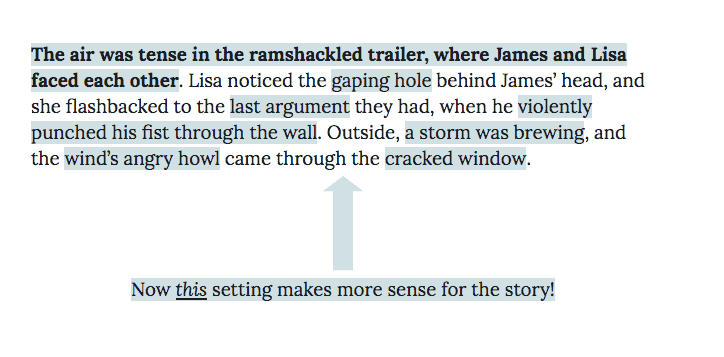
4. Incorporate all elements of a story
Remember that the setting of a story includes more than the terrain, weather, and climate of the place.
We already discussed some of the other elements that are involved in the setting of a story. Some of these are the government, religion, superstitions, and population. But how do you write them into your story?
You should know all these little details in depth, but it doesn’t mean you’ll use it all directly in your story’s setting.
Only use what’s necessary to describe the setting adequately. No more. No less. Write it in surrounded by action, and don’t forget to break it up throughout the story.
Setting descriptions aren’t only needed in the beginning, but everywhere you need the plot deepened and your characters enhanced.
5. Use all five senses when you’re describing the setting
When you’re walking through a room or down the street, do you see it as two-dimensional? No. You experience every part of that walk. You use every one of your five senses.
You want your readers to experience your story through each of their senses, too. An easy way to do this is by using literary elements in your writing.
Begin by describing what you want them to see. When you do, describe it the same way the eye travels in real life. Start with the focal point, then move across in a straight line.
Next, your main character would naturally notice what they hear. Don’t describe everything they hear, just the most relevant and obvious ones.
What do they smell? Is the air dusty? Is someone cooking breakfast?
Have them touch things. They can run their hand over the smooth desk, feel the rough board, and handle the cold metal rod.
Lastly, explore their sense of taste. Your main character won’t use this sense as much, but you do want to be sure to use it.
Remember, you don’t only taste when you put something in your mouth. Something can “smell so good that you can almost taste it.”
Sprinkle these details in – don’t feel that you have to describe each and every little thing; otherwise, you’ll overwhelm your reader.
Practice writing some scenes, and it will start to come naturally to you!
6. Don’t describe the setting of a story all at once
You don’t want to give your readers an encyclopedia of facts. They won’t read them. They’ll skip them, or might even close your book altogether.
When you start your book with a wall of details, your readers are more likely to put down your book to never pick it up again. Your readers will skim or skip later clumps of setting as they try to get back to the action.
Since the setting of a story is so essential to the plot and characters, it’s very important that you stretch it out enough that it will be read and enjoyed.
Write the setting in as part of the action, adding in a piece here and there.
A tip: Learn how to write dialogue in a way that engages your reader and helps build the setting. You can experiment with first-person, second-person POV, and third-person POV to find the best way to pull people into the setting.
Here is an example of a well-written piece.
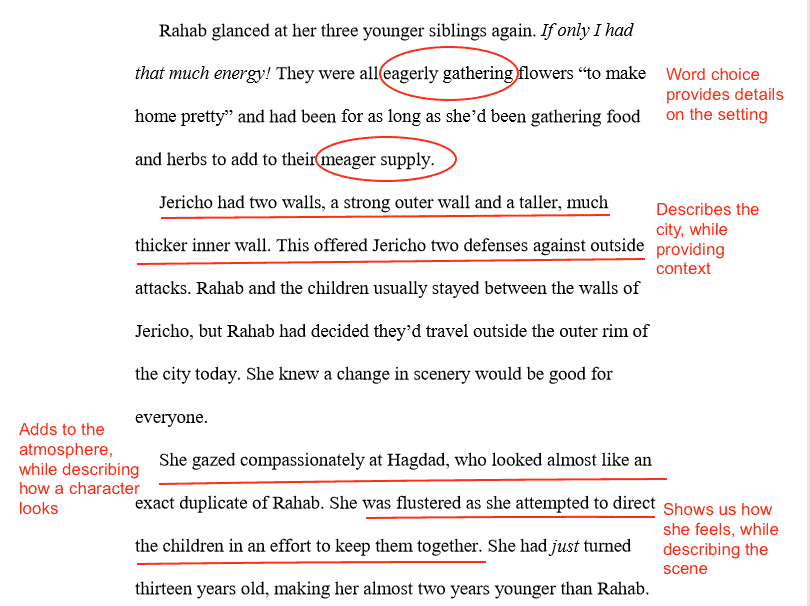
7. Don’t over-describe the setting of a story
Here’s why you shouldn’t over-describe the setting of a story:
- You stifle your reader’s imagination.You must leave some details up to the imagination. You want your readers to be involved in the story. Otherwise, you’ll lose them.
- You knock your readers out of the story. The quickest way to get a reader to desert your story is to front-load them with too many descriptions.
- You don’t need to include every detail. Appeal to your readers’ knowledge of the world. Tell your readers the machine sounds like a buzzing bee. You don’t need to describe the sound.
8. Remember that the setting of a story has a direct effect on the character and plot
Our environment affects our mood – this is true for almost every human! So, it shouldn’t be any different for the characters in your story, since they should be life-like.
Let’s look at some examples.
If Lisa lives in mid-Michigan, where it’s dark and dank all winter long, she may become depressed as many people do.
If she lives in a trailer in the middle of nowhere with the frigid air seeping in through the cracks in the door and a furnace that won’t stay lit, her character will beg for our sympathies.
If she has a toddler playing on the cold floors and a deadbeat ex-boyfriend who won’t provide for his child, we have the beginning of a plot.
Do you see how the plot and characters are directly affected by the story’s setting?
You might be thinking, “That’s all good and well, but what if I want to create a setting in a science-fiction or fantasy realm?” Let’s discuss some tips for writing a compelling fictional setting.
Our top tips for how to write a fictional setting
If you want to create the setting of a story that takes place in a world that doesn’t exist yet, creating a fictional setting is an option! There are few ways to do this.
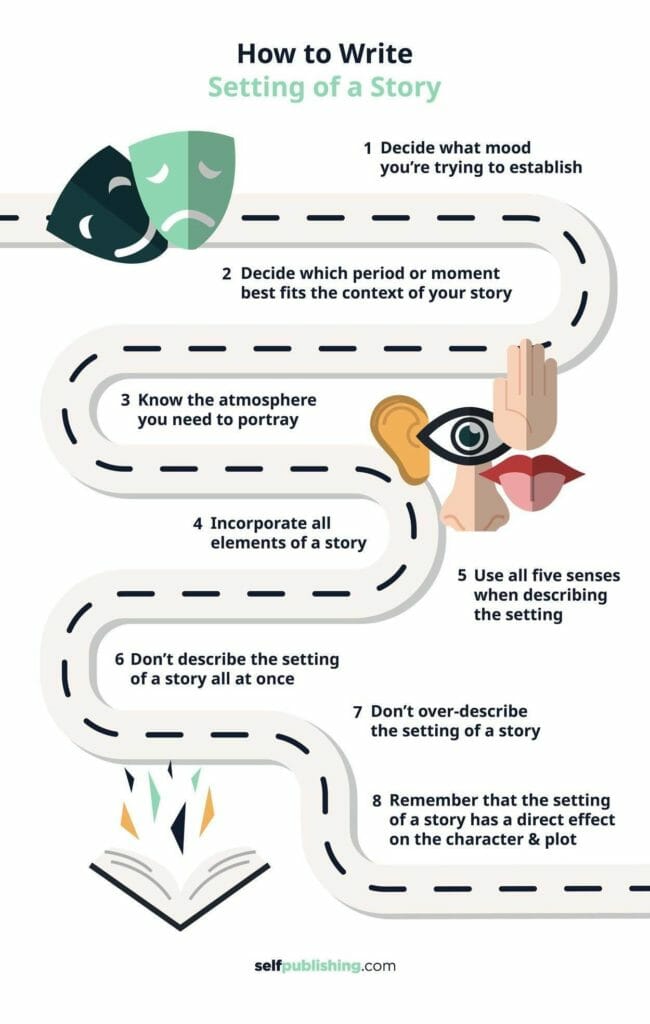
Develop the setting fully before you begin writing
Before you pick up your pen to write, be sure that your setting is fully developed!
You don’t want to get to the end of your book, only to edit it and find you have to rewrite large portions. Fully developing the setting of a story will save you hours of work later.
Not fully developing your story from the beginning could end with it back in the writing stage after an edit!
Sit down. Answer all the questions in the section on how to research a setting. Make notes, whether that be in a Microsoft document, Scrivener, Pinterest, Evernote, the project notebook method, or some other method.
Think about this: J. R. R. Tolkien had his setting researched so thoroughly that he had books full of information on the world and the characters before he even began writing.
Create your world first
You have an exciting task ahead of you: You get to create a world! And no one can tell you that you’re doing it wrong. However, world-building can be hard.
Not only is it time-consuming, but it’s difficult to form an immediate connection between your setting and your readers.
They won’t have any idea what an “ebony irbit” looks like, and your main character won’t be able to tell them that it’s “fluffy as a bunny” or “that it jumps like a grasshopper” since she’ll have no reference for such things. You’ll have to describe everything in detail.
Create your setting second
Once a fictitious world is built, the setting of a story can be created.
You need to create every aspect of your story’s setting before you move onto writing your book.
For example, how many suns will your main character look up and see? How many moons?
What about the plant life? Are the plants vibrant or dull? Where do they grow? Are they populous? Are they carnivorous? Do the characters eat of the plants? How do they get the fruit and vegetables?
Are the animals simple pets or advanced creatures? Do they live in peaceful harmony, almost symbiotic, or are they at constant war with the population?
Think outside the box when it comes to creating the setting of a story for a fictional world.
You need enough details to make the world believable
You need more details in a fictitious setting than you do in a real setting—the reason being that your readers have no frame of reference from which to draw.
For context: People have a pretty good idea what the Manhattan skyline looks like, but you’ll have to describe the horizon of your world looks like in detail.
You indeed want us to use our imagination, but it’s your job to guide it.
We need to know the color of the sky if it’s anything other than blue. We need to know about the acid rain that comes every night and cleanses the land of the evil creatures that dare prowl in the dark.
Tell us about the magician’s lair that Jabesh fell into while running through the woods. Describe the water running down the walls and how he felt a cold chill run down his spine as he peered into the darkness leading toward a single burning torch.
Give us details. Use specific words. Tell us what we need to know, but don’t pile it on. And remember, don’t give it to us all at once!
Draw a map
Learn how to make a fantasy map.
What’s the terrain in the whole country like? Draw it in.
Figure out the important places in your story. What is the capital city of Neiphour? What is the main throughway? Where is Jabesh traveling to? What little towns might he stop at along the way? Even include his favorite hideaway and his fishing hole. Include everything of importance.
Map out the distance between places. This way you won’t have Jabesh taking a two day trip to the city of Lit one day and a half-day trip the following week.
Not only will drawing a map of your world help you create the story’s setting, but it will also help both you and the reader envision little nuances to make it more realistic.
FAQs about story settings
Still have questions about what the setting of a story is, and how to craft a powerful one that hooks readers? You might just need to read more and practice writing settings on your own!
We get a lot of common questions on story settings, so we’ll cover some of the most frequently asked questions on the topic.
What are the three types of setting?
The three types of setting are the elements of time, place, and environment (both physical and social). Each of these types contributes to building the setting of a story.
How do you find the setting of a story?
To find the setting of a story, you will have to read through the book or story, and identify sections where the time, place, and environment is being described.
It is easy to identify the setting of a story through detailed descriptions the author may include that tells the reader when and where the story is taking place. An expert author also incorporates elements of setting subtly for the reader, such as through dialogue.
How does setting affect the story?
Setting affects the story by contributing to the plot, character development, mood, and theme. It also affects the story by engaging the reader and helping them visualize the events and context in which the narrative is being told.
What makes a good setting?
A good setting is one that appropriately describes the time, place, and environment of the narrative. A good setting also helps to connect the plot to the characters, and builds the mood and theme appropriately.
Practice writing the setting of a story today!
You’ve heard several tips and received a lot of information on how to write the setting of a story. I’ve told you how to create an engaging setting. Now, it’s time to practice!
If you need some inspiration to guide you, use this writing prompt generator to help think of things to write about.
Writing Prompt Generator
for Book Ideas
I want to write...
Genres
Writing Prompt Generator
for Book Ideas
Your Book Prompt:
Go to your desk, pull out your pen and paper, and begin mind mapping your setting. Write the place of your setting in the middle of the paper and circle it.
Now, set a timer for ten minutes. If that doesn’t end up being enough time, work longer.
Write everything you can think of about that setting. You’ll be surprised at how much you know! If your setting is fictitious, all the better. With these tips, and a little practice, you will master the art of setting in no time.

